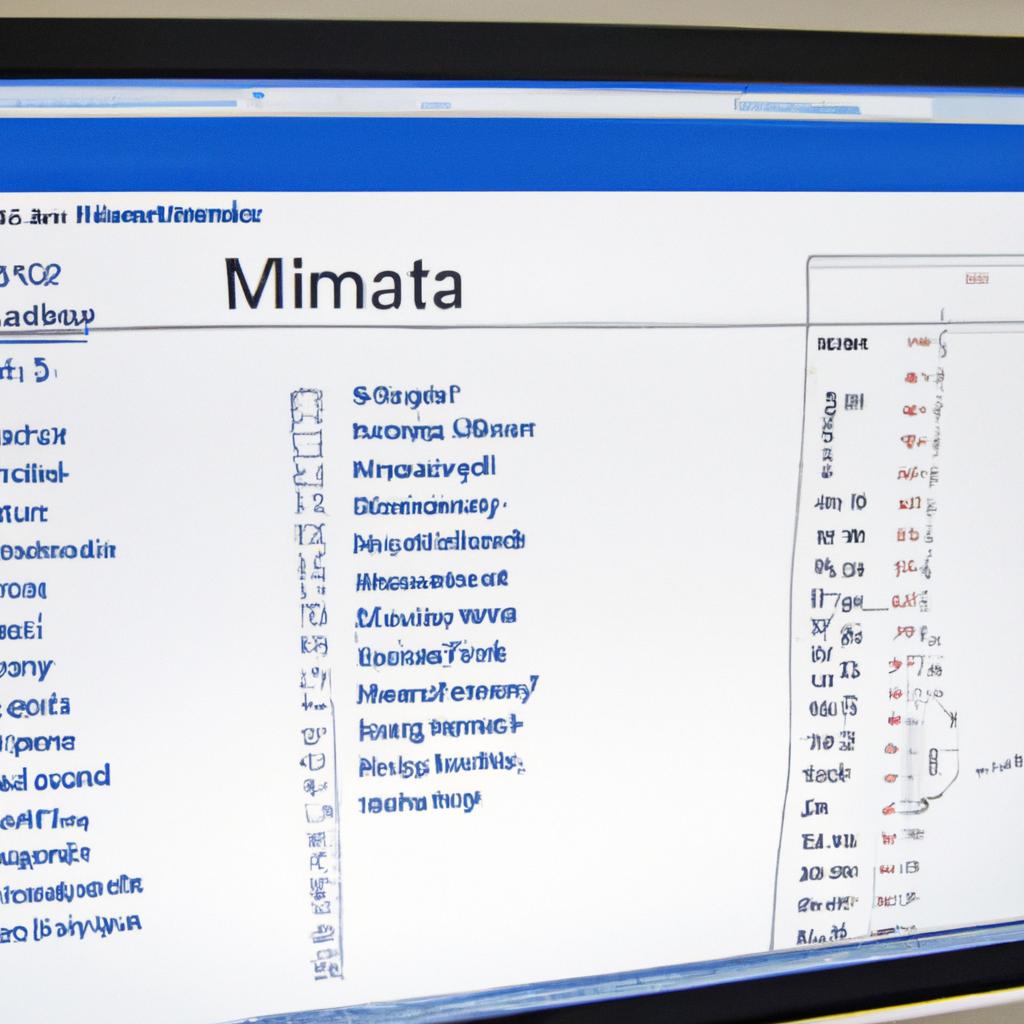Laboratory Data Management System: The Key to Streamlining Your Research and Development
As a researcher or scientist, you know that managing data is crucial to the success of any project. With the vast amount of data generated in laboratories every day, it can be overwhelming to keep track of everything. That’s where a laboratory data management system comes in.
A laboratory data management system (LDMS) is a software system designed to manage and organize laboratory data securely and efficiently. It streamlines the workflow, increases efficiency, and ensures compliance with regulatory requirements, making it an essential tool for any laboratory.
In today’s fast-paced world of research and development, having an LDMS is not just an option; it’s a necessity. In this article, we’ll explore the benefits of LDMS, the types available, factors to consider when choosing one, and best practices for implementation. Let’s dive in.
Features and Benefits of Laboratory Data Management System

In today’s rapidly evolving research landscape, laboratory data management systems (LDMS) offer a range of benefits to researchers and scientists. Here are some of the key features and benefits of using an LDMS in your laboratory.
Data Security and Privacy
An LDMS offers a range of tools to ensure the security and privacy of your data. It enables you to control access to your data, thereby minimizing the risk of data breaches. It also enables you to securely store and share data with authorized personnel, ensuring that your data remains confidential and secure.
Data Storage and Retrieval
An LDMS offers efficient data storage and retrieval capabilities. It enables you to store and organize data in a centralized location, making it easy to find and retrieve specific data when needed. It also enables you to search for data using specific criteria, thereby saving time and increasing efficiency.
Data Analysis and Reporting
An LDMS offers powerful data analysis and reporting capabilities. It enables you to analyze large datasets quickly and efficiently, making it easy to identify trends and patterns. It also enables you to generate reports based on your analysis, making it easy to communicate your findings to stakeholders.
Streamlined Workflow and Increased Efficiency
An LDMS streamlines the workflow in your laboratory, making it easier to manage and organize data. It eliminates the need for manual data entry, thereby reducing errors and increasing efficiency. It also enables you to automate routine tasks, freeing up time for more critical tasks.
Compliance with Regulatory Requirements
An LDMS ensures compliance with regulatory requirements. It enables you to track data from the point of generation to the point of disposal, ensuring that you meet regulatory standards. It also enables you to generate audit trails, making it easy to demonstrate compliance.
Improved Collaboration and Communication Among Team Members
An LDMS improves collaboration and communication among team members. It enables you to share data with authorized personnel, making it easy to collaborate on projects. It also enables you to communicate with team members using built-in communication tools, making it easy to stay in touch.
Types of Laboratory Data Management Systems

When it comes to choosing an LDMS, there are three types to consider: on-premise, cloud-based, and hybrid. Each has its own unique features and benefits, and choosing the right one for your organization depends on your specific needs and requirements.
On-Premise Laboratory Data Management System
An on-premise LDMS is installed locally on your organization’s servers and managed by your IT department. It provides complete control over your data and allows for customization to meet your specific needs. However, it requires a significant initial investment in hardware and software, as well as ongoing maintenance and support costs.
Cloud-Based Laboratory Data Management System
A cloud-based LDMS is hosted on a remote server and accessible through the internet. It offers the most flexibility and scalability, as well as lower upfront costs, as you only pay for what you use. It also allows for easier collaboration and data sharing among team members. However, security concerns and dependence on internet connectivity may be potential drawbacks.
Hybrid Laboratory Data Management System
A hybrid LDMS combines the benefits of both on-premise and cloud-based systems. It allows for greater control over data security and customization, while also providing the flexibility and scalability of a cloud-based system. It can be a good option for organizations that require greater control over their data but also want the benefits of cloud-based technology.
Choosing the Right Type of Laboratory Data Management System for Your Organization
Choosing the right type of LDMS for your organization depends on various factors, including data security requirements, budget, IT infrastructure, and project needs. It’s crucial to evaluate each type carefully and consider your organization’s long-term goals and objectives before making a decision.
Factors to Consider When Choosing a Laboratory Data Management System
When selecting an LDMS, several factors must be considered to ensure it meets the laboratory’s unique needs and requirements. Here are some critical factors to consider:
A. Compatibility with Existing Laboratory Equipment and Software
An LDMS must be compatible with the laboratory’s existing equipment and software to avoid costly disruptions to the workflow. Compatibility ensures seamless integration of data from different sources, reducing data entry errors and discrepancies.
B. Scalability and Flexibility
As laboratories grow and evolve, their data management needs change. Thus, it is essential to choose an LDMS that is scalable and flexible enough to adapt to changing needs. A scalable LDMS can accommodate increased data volumes and users, while a flexible LDMS can be customized to meet specific laboratory requirements.
C. User-Friendliness and Ease of Integration
An LDMS should be easy to use and integrate with existing laboratory workflows. It should have a user-friendly interface and an intuitive design that reduces the time and effort required to learn and use the system effectively. Additionally, it should integrate seamlessly with laboratory instruments and systems, reducing manual data entry and potential errors.
D. Availability of Technical Support and Training
Technical support and training are essential when implementing an LDMS. The vendor should provide comprehensive training to ensure laboratory personnel can use the system effectively. Additionally, the vendor should have a reliable technical support team available to address any issues that arise during implementation and use.
E. Cost and Return on Investment
Finally, the cost of the LDMS and the potential return on investment (ROI) must be considered. The LDMS should provide tangible benefits that justify the cost, such as increased efficiency, reduced errors, and improved compliance. A detailed cost-benefit analysis can help identify the LDMS’s true value and ensure the best possible RO
Laboratory Data Management System Implementation and Best Practices
When it comes to implementing a laboratory data management system (LDMS), proper planning and preparation are vital. Here are some best practices to follow for a successful implementation:
A. Planning and Preparation
The first step in implementing an LDMS is to define the scope of the project and establish realistic timelines and budgets. It’s crucial to involve all stakeholders in the planning process to ensure that everyone is on the same page and that the project’s goals align with the laboratory’s objectives.
B. Data Migration and Integration
Migrating data from legacy systems or manual processes to an LDMS can be a complex process. It’s essential to have a clear understanding of the data’s structure and format to ensure a smooth transition. Additionally, integrating the LDMS with existing laboratory equipment and software can help streamline workflows and increase efficiency.
C. Testing and Validation
Before the LDMS goes live, it’s crucial to perform extensive testing and validation to ensure that it meets regulatory requirements and performs as expected. This includes verifying data integrity, ensuring proper backup and recovery procedures are in place, and conducting user acceptance testing.
D. Training and User Adoption
Proper training and user adoption are critical to the success of an LDMS. It’s essential to provide comprehensive training to all users to ensure that they understand how to use the system effectively. Additionally, having a user-friendly interface and offering ongoing support can help encourage user adoption.
E. Continuous Improvement and Monitoring
Once the LDMS is in place, it’s crucial to monitor its performance regularly and make adjustments as needed. This includes conducting regular audits, implementing new features or updates, and continuously seeking feedback from users to improve the system’s functionality.
By following these best practices, laboratories can ensure a successful implementation of an LDMS, leading to increased efficiency, streamlined workflows, and improved data management.
Conclusion
In conclusion, a laboratory data management system is a critical tool for any laboratory that wants to streamline their workflow, increase efficiency, and ensure compliance with regulatory requirements. With the vast amount of data generated in laboratories every day, it’s crucial to have a system in place to manage and organize it securely and efficiently.
When choosing an LDMS, it’s essential to consider factors such as compatibility with existing equipment and software, scalability, user-friendliness, technical support, and cost. It’s also crucial to follow best practices for implementation, including planning, preparation, data migration, testing, training, and continuous improvement.
By implementing an LDMS, laboratories can optimize their processes, reduce errors and duplication, and improve collaboration and communication among team members. It’s time to take your laboratory to the next level with a laboratory data management system.
So, what are you waiting for? Invest in an LDMS today and take the first step towards streamlining your research and development processes.

Comments are closed.